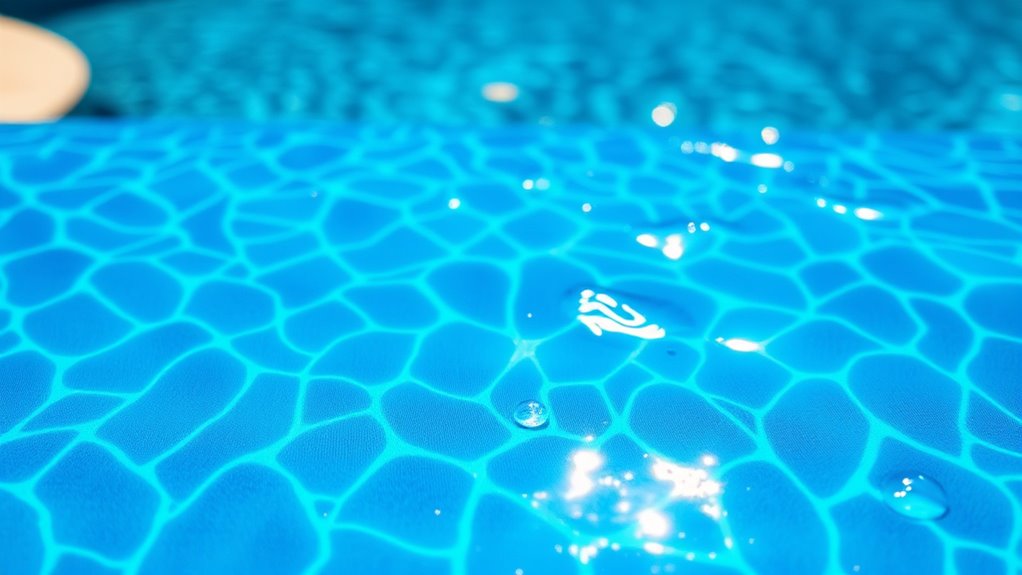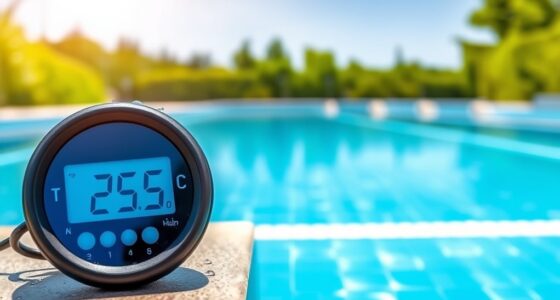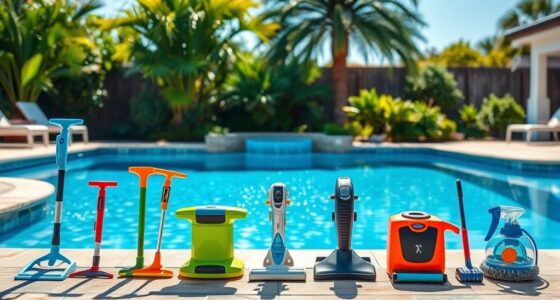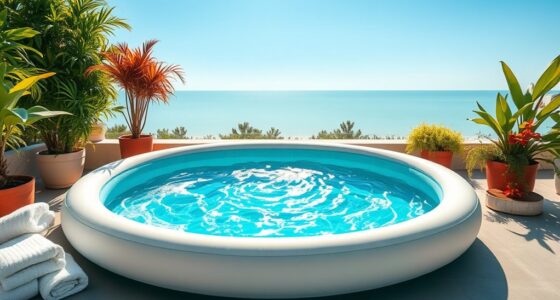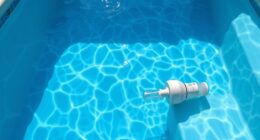When it comes to pool liners, you’ve got several materials to choose from, including vinyl, fiberglass, and reinforced membranes. Vinyl liners are budget-friendly but can struggle with punctures and fading over time. Fiberglass offers a smooth, algae-resistant surface but requires special installation skills. Reinforced membranes provide durability and eco-friendliness. Remember, maintaining your pool liner with regular checks and repairs is key to its longevity. Staying informed about each option will help you make the best choice for your pool.
Key Takeaways
- Pool liners come in various materials, including vinyl, reinforced membrane, fiberglass, concrete, and polyester shells, each with unique durability features.
- Vinyl liners are cost-effective but prone to punctures and fading, requiring regular maintenance to extend their lifespan.
- Reinforced membrane liners offer excellent durability and watertightness, making them eco-friendly and resistant to wear over time.
- Fiberglass liners provide a smooth surface that resists algae growth but require specialized skills for installation and maintenance.
- Regular inspections and cleaning are crucial for all types of pool liners to identify issues early and ensure longevity.

When it comes to maintaining a beautiful and functional pool, choosing the right liner is vital. You’ll find various materials available, each offering unique benefits and drawbacks. Understanding these options can help you make an informed decision that matches your needs and budget.
Reinforced membrane liners are a solid choice, featuring polyester nets covered by PVC sheets. They provide excellent watertightness and durability, making them ideal for long-term use. On the other hand, vinyl liners are popular among pool owners due to their affordability and versatility. They come in a plethora of colors and patterns, allowing you to customize your pool’s look effortlessly.
Reinforced membrane liners offer durability and watertightness, while vinyl liners provide affordability and customization options for your pool.
If you’re after superior durability, consider fiberglass liners. They boast a smooth, non-porous surface that resists algae growth, which can save you time on maintenance. Concrete and painted concrete can also serve as foundational structures for other liners, while polyester shells provide a robust base for your chosen liner.
When it comes to durability, liner thickness plays a significant role. Most liners range from 0.45 mm to 1.5 mm thick, and thicker materials generally offer more protection against wear and tear. While vinyl liners are budget-friendly, they can be prone to punctures, especially compared to fiberglass or reinforced membrane options. Additionally, prolonged sun exposure can cause vinyl to fade over the years, affecting its overall appearance.
Despite some drawbacks, pool liners have many advantages. Both vinyl and reinforced membrane liners offer cost-effectiveness and ease of installation. If sustainability is a concern for you, reinforced membrane liners are made from recyclable materials, making them an eco-friendly option. Fiberglass liners, while initially pricier, deliver a luxurious swimming experience with their smooth surface.
However, be mindful of the disadvantages. Vinyl liners’ susceptibility to punctures can be a headache, and their color may fade over time. Fiberglass installations require specialized skills and equipment, which can complicate the process. You’ll also have fewer design options with fiberglass compared to vinyl.
Regular maintenance is imperative for extending the life of any pool liner. Cleaning is essential, especially for vinyl, to keep it looking fresh. If you encounter minor punctures with vinyl, repairs are relatively simple. However, fiberglass may need specialized tools for maintenance.
Ultimately, you should inspect your liner regularly to catch any issues before they escalate, ensuring your pool remains a stunning oasis for years to come.
Frequently Asked Questions
How Do I Choose the Right Pool Liner Color?
Choosing the right pool liner color is essential for creating your desired aesthetic and environment.
Think about how the color will interact with your landscaping and existing features. Lighter colors can enhance visibility and make the pool feel larger, while darker shades warm the water.
Consider the maintenance required for each color, too. Ultimately, pick a hue that resonates with you and fits well with your overall design vision for the space.
Can I Install a Pool Liner Myself?
Yes, you can install a pool liner yourself, but it requires some planning and skill.
Start by draining the pool and removing the old liner if necessary. Measure accurately to guarantee the new liner fits properly.
Gather the right tools and consider getting help from friends, especially for larger inground pools.
Follow the manufacturer’s instructions closely to avoid mistakes. If you feel unsure, hiring a professional might be a safer option.
What Is the Average Lifespan of a Pool Liner?
Imagine your pool liner as a protective shield, gracefully guarding your oasis.
On average, a pool liner will last about 10 years, but several factors can sway that number. With high-quality materials and diligent care, you might stretch its life even further.
Keep an eye out for cracks or fading, as these signs often whisper it’s time for a replacement. Regular maintenance can help you enjoy your pool for longer, turning splashes into memories.
Are There Eco-Friendly Pool Liner Options Available?
Yes, there are eco-friendly pool liner options available.
You can consider fiberglass liners, which are fully recyclable and last over 25 years with proper care.
Another option is ReNew vinyl, made with 51% pre-consumer recycled content, reducing plastic waste.
How Can I Prevent Pool Liner Damage During Winter?
Preventing pool liner damage during winter is like wrapping a gift to keep it safe.
Start by cleaning the liner and balancing the water chemistry. Lower the water level below the skimmer, then apply winterizing chemicals.
Use a high-quality pool cover to shield against debris and ice. Regularly inspect for any tears or damage, and don’t forget to monitor the water level to avoid pressure from freezing conditions.
Take these steps to protect your investment!
Conclusion
When it comes to choosing the right pool liner, understanding the materials and their durability is essential. You’ve got options like vinyl, fiberglass, and concrete, each offering unique benefits. By weighing these factors, you’ll guarantee your pool not only looks great but lasts for years to come. So, why settle for anything less than the best for your backyard oasis? Making the right choice can transform your swimming experience and protect your investment for the long haul.
